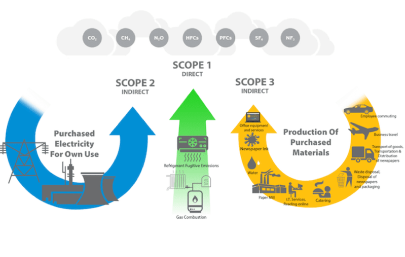
Trakref
ESG Data Strategies for Multi-Site Facility Operators

Environmental, Social, and Governance (ESG) criteria create a framework that organizations employ to assess and report their effects on society and the environment. These three pillars intersect and influence an organization’s overall performance. Building a foundation of trust between a company and its stakeholders depends on data quality. Meeting the expectations of investors, regulators, and consumers requires meticulous data collection and reporting.
Strong data practices contribute directly to building trust, but coordinating information from multiple locations introduces unique obstacles—many of which are often overlooked. Keeping up with diverse methodologies and frameworks in ESG reporting and data gathering can be challenging, but standardization and consistency are crucial for uncovering valuable insights.
Steps to Improve Multi-Site ESG Data Collection
As Environmental, Social, and Governance criteria influence the corporate agenda, multi-site facility operators encounter unique challenges in gathering ESG data due to the complexity of coordinating across varied locations, each with distinct operational processes.
To support this process, developing a strong ESG data collection strategy is crucial. This strategy must be flexible enough to integrate with different facility operations, and scalable as the company grows.
Facility operators can take the following steps to enhance ESG data collection:
- Establish clear data protocols: Each facility should have a clear set of guidelines that dictate how data is collected, managed, and reported.
- Put technology to use: Deploy smart meters and IoT devices to automate the collection of environmental data such as energy and water usage.
- Train staff regularly: Ensure that all team members understand the importance of ESG data and how to collect it accurately.
- Conduct regular audits: Frequent evaluations of the data collected can help identify inconsistencies or areas for improvement.
The demand for accountability has never been greater, making ESG reporting both a serious obligation and a key component in today’s business world. Companies must prioritize clear, standardized reporting to meet expectations and regulatory demands.
Where ESG Reporting is Used
ESG reports have multiple audiences, with each interpreting the data differently. In financial markets, these reports inform investment decisions. Institutional investors rely on ESG metrics to evaluate a company’s risk and long-term viability. Successfully combining ESG data with other types requires strong data management strategies.
Facility operators are often responsible for managing the environmental aspect of ESG. From on-site fossil fuel combustion to managing energy efficiency measures, facility operators are at the frontline in gathering data and implementing eco-friendly practices. They must be aware of Scope 1, 2, and 3 emissions and have strategies in place for monitoring and reducing them.
SEC Climate Disclosure
The Securities and Exchange Commission (SEC) in the US often requires companies to disclose climate-related risks. Lack of compliance can lead to financial penalties and legal challenges. Compliance demands ongoing adjustments to align with global and local standards, despite inconsistent regulations posing a challenge for organizations.
CSRD
The Corporate Sustainability Reporting Directive (CSRD) in the European Union also mandates more ESG disclosures and reporting. Being aware of and adapting to these regulations can streamline the reporting process and enhance comparability.
C-Suite / Shareholders
For upper management and shareholders, ESG reporting offers valuable insights into a company’s operational ethics and sustainability initiatives. Investors, regulators, and consumers now require a high level of transparency. These reports can significantly impact a company’s stock prices and market reputation, making them integral to business strategy discussions.
Credit Providers
Financial institutions find value in ESG reports too. Lenders and other credit providers rely on ESG reports when making financing decisions. They gauge the organization’s commitment to social and environmental responsibility, which in turn affects interest rates and loan terms.
The ESG reporting process has evolved from a peripheral corporate social responsibility activity to a critical aspect of modern business operations. ESG reporting serves multiple stakeholders and aligns with various regulatory standards. Companies must adapt swiftly and wisely to global reporting standards to meet these challenges.

What Makes up the Environmental (E) of ESG
The environmental aspect of ESG focuses on a company’s ecological footprint, or how they interact with the natural world. This is broken down into various components, including but not limited to the following sections.
Scope 1 Emissions & Data Collection
Direct emissions from sources owned or controlled by the reporting company. Common examples include emissions from on-site combustion of fossil fuels in boilers, furnaces, and vehicles owned by the company. Additionally, this includes emissions from refrigerant leaks in HVAC/Refrigeration systems.
Data collection is related to:
- Fuel Consumption – Different types of fossil fuels consumed onsite like coal, oil, natural gas, propane, and diesel. Information is found in vendor bills and location-specific records, as well as usual records for combustion equipment like boilers, furnaces, and generators.
- Transport Assets – Data regarding the company’s vehicle fleet, such as the number of vehicles, fuel consumption, and types of fuel used.
- Industrial Processes – Emissions from chemical reactions such as cement production or chemical manufacturing.
- Fugitive Emissions – Unintentional releases of refrigerant gases from HVAC systems, recorded by type, lbs., and global warming potential (GWP).
Scope 2 Emissions
These emissions result from activities an organization doesn’t directly control but has influence over through its energy purchasing decisions. They typically result from the consumption of purchased electricity, heat, or steam.
Data collection is related to
- Energy consumption data – The amount of electricity, heat, steam, or cooling purchased or consumed by an organization during the reporting period. Data should be broken down by source, such as grid electricity, on-site generation, and more.
- Location-based vs. market-based reporting – Location-based reporting uses average grid emission factors for the region where an organization operates. Market-based reporting considers contractual instruments like renewable energy certificates (RECs) or power purchase agreements (PPAs) that could impact the emissions associated with an organization’s energy consumption.
- Renewable energy data – Helps calculate emissions reductions due to the use of cleaner energy sources.
Scope 3 Emissions
These encompass all other indirect emissions that occur in the value chain of the reporting company, including both upstream and downstream activities. This category often has the broadest impact and can include emissions from transportation, employees commuting, supply chain activities, and more.
Keys to Data Collection
Involving all stakeholders sets the foundation for successful ESG data collection. Implementing solutions like Trakref, Persefoni, and Watershed streamline the process—especially across larger portfolios.
Once the right tools are in place, working closely with vendors is the next important step. Vendors are instrumental in providing annual data on:
- Propane used for forklifts
- Fuel used for onsite generation
- Refrigerant leaks managed by HVAC contractors
- Electricity consumption metrics from utilities
ESG reporting is both a measure of corporate responsibility and an indicator of an organization’s long-term sustainability and risk management strategies. Organizations need to adapt their ESG reporting data collection processes promptly and effectively.
Fexa Trakref is Fexa’s Refrigerant Management and HVAC/R Compliance Software Solution. With its user-friendly interface and powerful features, Fexa Trakref empowers businesses to effortlessly track and manage refrigerant usage, ensure compliance with regulations, and optimize HVAC/R operations.



